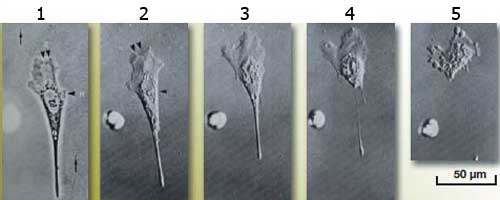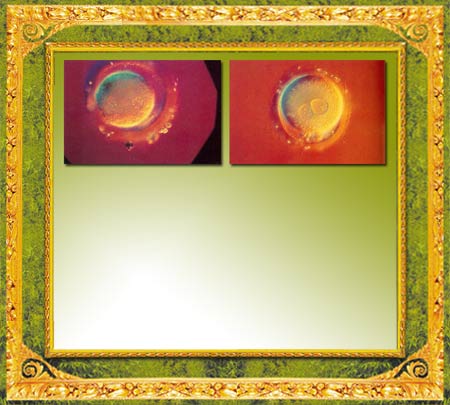Bigotry: The Dark Danger
The Miracle in the Cell Membrane

DOWNLOAD THE BOOK
CHAPTERS OF THE BOOK
- Foreword
- Introduction: The Consciousness Beyond Matter and The Col Lapse of Mechanism
- The Miniature Factories Comprising Our Bodies: The Cells
- The Cell's Complex Structure Can not Be Explained in Terms of Coincidence
- Superior Creation in The Structure of The Cell Membrane
- Complex Transportation Systems in The Cell Membrane
- The Selective Permeability of The Protein Channels in The Cell Membrane
- Selectivity in Nerve Cells
- Signal Selection in Traffic of Data Among Cells
- Selection in The Immune System's Cells
- Vital Selections in The Blood
- The Importance of The Creation in The Cell Membrane in Terms of Multi-Cellularity
- The Delicate Balance in Substances Selected in The Body
- The Cell Membrane Invalidates Claims of The Theory of Evolution
- Conclusion: Allah Pervades Everywhere With His Wisdom
< <
12 / total: 15
The Importance of The Creation in The Cell Membrane in Terms of Multi-CellularityHow Does a Cell Select the Cell to Bind to?The surface of a typical cell is not smooth, but rough. Most cells make contact with one another by means of micro-protrusions on their surfaces known as phyllopods, which are generally no longer than 0.1 microns in length and cover no more than 1/100th of a square micron. The cell uses these micro-protrusions as if they were fingers, to discover its environment and feel the surfaces of other nearby cells.
Binding to another cell takes place as a result of special molecules on these micro-protrusions. Binding molecules, present in pairs, bind with their mutually complementary surfaces. Proteins apply the lock-and-key recognition principle they use to recognize substances. The bond between two binding molecules is known as the affinity link, whose strength consists of the totality of various weak chemical bonds that attach two molecules together. The external surfaces of cells are negatively charged. For that reason, cells repel each other electrostatically. Under these conditions, it would appear impossible for them to remain in physical contact with one another. But because of the cell membrane's special Creation, cells are able to do just that. Along with a decrease in the field of contact in these micro-protrusions in the cell membrane, the repellent effect here is also reduced and ceases to represent any obstacle. The binding of cells by micro-protrusions also plays an important role in the cell's direction-finding. For example, cells migrating in the body of a developing embryo adhere to a large number of other cells until they find their intended destination. They thus open the path before them by repelling other cells and continue to extend these protrusions in many directions until the correct contact is made. If a cell did not possess the ability to extend these protrusions, then it would be as impossible for it to find its way, no more than a human can do so in the dark without using his hands. Here, however, the wealth of Allah's knowledge again reveals the perfection of the Creation in the entities He has created.
To establish an affinity link between cells, the distance between the surfaces of the two complementary adhering molecules must be less than 1 nanometer, and they must be correctly aligned. It is difficult for these conditions to be met, yet binding still takes place, even if the links in the cell membrane not approach one another to the requisite extent. These links are strong enough to bear a 40-nanogram weight (1 nanogram = 1 billionth of a gram). If the affinity links between cells were not that strong, it would be exceedingly difficult for one cell to bind to any other. Many cells can establish bonds to other cells by means of a single protrusion; this can constitute a permanent bond by means of two affinity links. Were the affinity links in this bonding system a few times weaker, the cell could not attach to another. In addition, proteins would not be stable, and enzymes would not bind to the relevant substances. If these links were stronger, then it would be very hard for bonded cells to separate from one another. As you have seen, there is a most delicate balance for one cell to be able to bind to another, and it is impossible for that equilibrium to have attained its ideal form by trial and error.
Another of the Cell's Essential Abilities: CrawlingIf cells could not move, life would be impossible. During crawling, the cell extends fan-like protrusions known as lamellae that permit a temporary attachment to the adjacent surface and slide forward, dragging the cell behind them. This process is made possible by the cell's constantly changing shape. To do so, that the cytoplasm inside the cell wall must have the property of a semi-solid and be adhesive in such a way as to form protrusions extending to the outside. But at the same time, the inside of the cell must also have solid structural elements to constitute a flexible skeleton. Evidently, the cell's crawling ability depends on the cytoplasm being readily deformable so that the cell's interior can be drawn into an advancing protrusion. If too viscous, the cell's contents would be immobilized. The cell must be able to reversibly adhere to a substratum, and, as you just saw, the property of adhesion depends on the strength of weak chemical bonds. The cell must be able to generate enough traction to pull its mechanically rigid scaffold. If the viscosity of water, the energy levels of weak chemical bonds and the power of the traction forces were all slightly different from what they are, such crawling would likely be impossible.71 The cell's propulsive ability plays a vital role in all stages of bodily development.
The cell's crawling and binding also depend on its dimensions. If cells were 10 times smaller than they are, then their crawling would become impossible: It would be very difficult for the systems inside the cell to fit into a volume just 1/1000th of its size. Moreover, since the surface of the cell would also be 100 times smaller, the number of molecules able to attach to its surface would be reduced. It would be very difficult, too, for such small cells to form the complex protrusions that let them feel their way, and it would be impossible for the cell to perform vital functions such as bonding and crawling. Dr. Juliet Lee of the Connecticut University Molecular and Cell Biology Department made the following comment about the cell's ability to move in the wake of her research published in Nature magazine:
The cell's abilities to selectively bind and to crawl depend on the features of its cytoplasm and the structure of the cell membrane. Cytoplasm has a most plastic and mobile structure, ideally suited to crawling and binding. The cell's abilities to move and bind are possible only when cytoplasm possesses exactly the proper characteristics. DNA, protein, sugar and lipids—the basic compounds of life—also possess exactly the right structure and need to be present in the right proportions for the cell to maintain its activities and multiply. As a result of this, however, the cells are able to move and bind and thus, make larger organisms possible. In short, there is no room for gradual development in the structure of cells, as Darwinists claim. On the contrary, all of the cell's components and features constitute a whole, possessing a very special structure for the emergence of life. The famous British mathematician and astronomer Sir Fred Hoyle expressed the impossibility of claims of coincidence:
Footnotes71. Michael J. Denton, Nature's Destiny, New York: The Free Press, , 1998, p. 221. 72. http://www.unc.edu/news/newsserv/research/jul99/jacobson072199.htm 73. Fred Hoyle, "The Big Bang in Astronomy," New Scientist, Vol. 9, 1981, pp. 521, 527.
|
||||||||||||||||||||
12 / total 15
You can read Harun Yahya's book The Miracle in the Cell Membrane online, share it on social networks such as Facebook and Twitter, download it to your computer, use it in your homework and theses, and publish, copy or reproduce it on your own web sites or blogs without paying any copyright fee, so long as you acknowledge this site as the reference.




